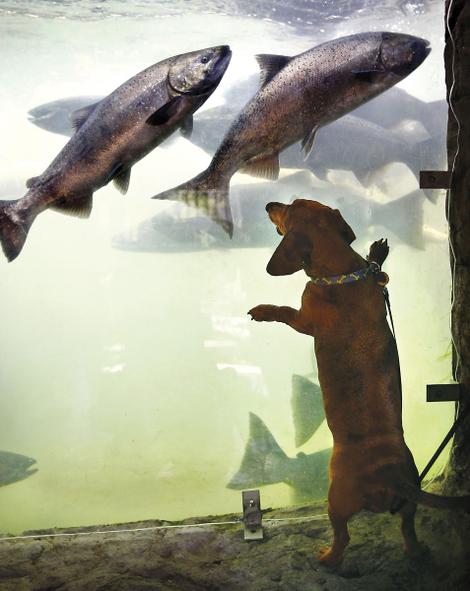forum
library
tutorial
contact

Best Catches Ever for Some Sporties
by Bill RudolphNW Fishletter, September 19, 2013
|
the film forum library tutorial contact |

|
Best Catches Ever for Some Sportiesby Bill RudolphNW Fishletter, September 19, 2013 |
 This year's fall Chinook run was expected to be really big, but not this big. The big surprise began around Sept. 4, after nearly 274,000 falls had been counted at Bonneville Dam. Above the dam, more than 700 tribal set nets were strung out in the choppy waters above the dam. Down in the lower river, sport fishers found the best catches since 1988.
This year's fall Chinook run was expected to be really big, but not this big. The big surprise began around Sept. 4, after nearly 274,000 falls had been counted at Bonneville Dam. Above the dam, more than 700 tribal set nets were strung out in the choppy waters above the dam. Down in the lower river, sport fishers found the best catches since 1988.
Managers and fishermen figured the run's peak day likely occurred on Aug. 30, when nearly 34,000 were counted at the dam. After that, daily counts were running about a third of that. The conventional wisdom said the run should be only half over by Sept. 7, judging from the last 10 years' worth of returns.
Then the fall run really picked up steam, and the new peak hit on Sept, 9, when nearly 64,000 Chinook were counted at Bonneville Dam.
At that point, sporties' catch figures included 15,500 Chinook kept (4,100 released) in the Buoy 10 fishery between Aug. 1-22, and another 6,800 kept (8,600 released) in the hatchery-fish-only periods from Aug. 23 to Sept. 1.
Catch estimates for the lower Columbia River recreational fishery included 12,600 Chinook kept (1,100 released), record high catches in August. The Buoy 10 fishery is now closed and the lower river fishery upriver of that transitioned to a mark-selective fishery between Sept. 6-12.
With the new run update on Sept. 16 that estimated the upriver bright run will reach at least 832,500, sporties have been given more time on the water, all the way until Sept. 30, with a two Chinook daily limit (below Warrior Rock), and two Chinook, hatchery or wild above, all the way to Bonneville Dam.
Lower river commercial fishermen landed 45,600 Chinook and 700 sturgeon in eight August fishing periods. Their late fall season begins around Sept. 15, with about 9,000 fall Chinook still available to them under this year's fishing regime, but with the run update they have been allowed more fishing time to get in on the bonanza.
Upriver of Bonneville Dam, tribal fishers were expected to catch about 72,000 fall Chinook by Sept. 7, which included 43,000 upriver brights (headed for the Hanford Reach), 18,000 McNary brights, 10,314 tules (Bonneville Pool hatchery fish), and 8,693 steelhead (936 B-run).
By the middle of September, managers expected the tribes to net another 50,000 fall Chinook, but concerns over a potential downgrade of the B steelhead run threatened to cut short their future harvest effort. With the run upgrade, the tribes now are getting more fishing time and are expected to catch more than 215,000 fall Chinook by Sept. 27, 138, 000 of them upriver brights. Six hundred nets are still fishing. It looks like the B-run steelhead quota will remain within bounds.
Fall Chinook began showing well in the Snake, early on, but low flows and high water temperatures at Lower Granite Dam kept most of the fish from moving into Idaho. More than 13,000 fall Chinook were counted at Ice Harbor by Sept. 4, the first project encountered by fish on the lower Snake, but only 2,700 or so had made it past Lower Granite, where flows hovered in the 20 kcfs range. Operators were trying a range of scenarios to try and aid fish passage, hampered by stratified water above the dam.
About 31,000 wild Snake fall Chinook were expected to enter the mouth of the Columbia this year, along with thousands of hatchery Chinook bound for the Snake. That estimate is likely to come up short as well. A hatchery-only fishery opened on the Snake Sept. 1, with a daily bag limit of six hatchery Chinook and an unlimited number of hatchery jacks.
The large returns to the Columbia are just part of the good news. Further north, Puget Sound was filling up with pink salmon. About 6 million are expected there. Canadian managers recently upgraded the Fraser's pink run to 26 million from a preseason estimate of about 9 million. The Fraser sockeye run, offspring of the disastrous 1.6 million-fish return in 2009, is expected to top out around 4 million this year.
In Alaska, pinks ruled. By Aug. 30, Alaska commercial fishermen had caught 210 million pink salmon, out of a total salmon catch of more than 261 million fish, nearly 78 percent greater than the forecast.
About 310 pinks had been counted at Bonneville by Sept. 17. In 2011, the last big pink year in Northwest waters, around 3,600 straying pinks were counted at Bonneville Dam. Nearly three dozen made it as far as Ice Harbor Dam that year.
Related Pages:
Snake Fall Chinook Run Poised for Best Wild Return since 1960's by Bill Rudolph, NW Fishletter, 9/19/13
learn more on topics covered in the film
see the video
read the script
learn the songs
discussion forum
